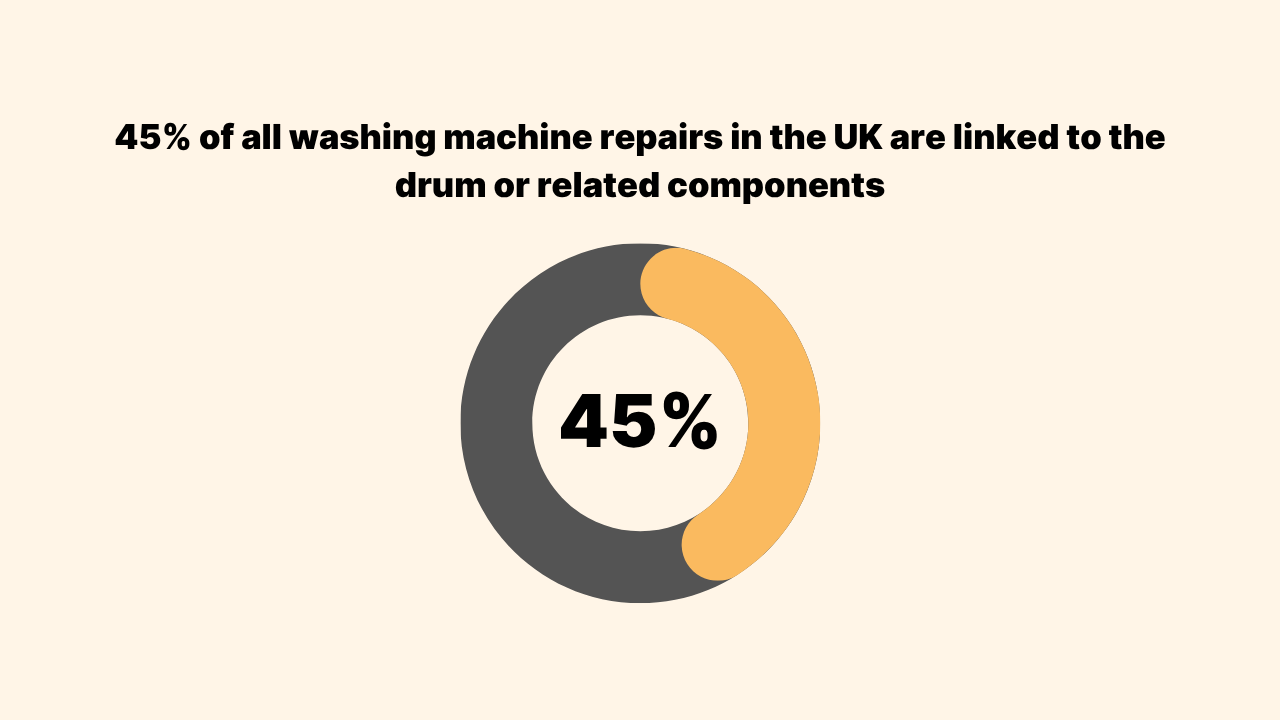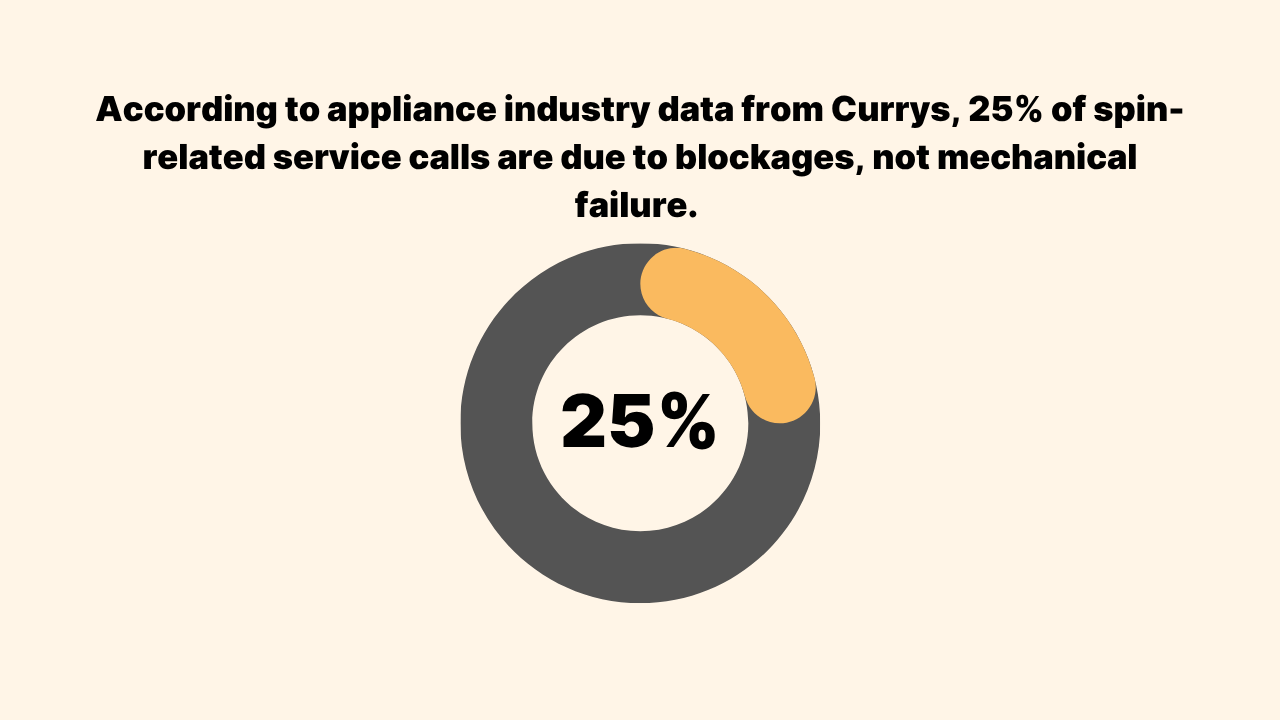Washing machines are the backbone of every clean pair of clothes in every household.
However, these helpful machines could also encounter problems that you never anticipated.
And… out of the hundreds of components that put together a washing machine, your washing machine drum is the most important.
If the drum fails to perform well, your machine will very likely break down.
In this guide, we’ll explore some of the common problems with washing machine drums and also provide you with some tips and tricks to help you resolve the problem yourself.
Let’s get started.
Introduction

That’s not a minor statistic.
That’s a clear signal to pay attention to the warning signs before you’re knee-deep in soapy water with a load of school uniforms waiting to dry.
This post breaks down the seven most common drum issues people face, not just with the “what” but the “why”.
Why it happens, what it means for your machine, and whether it’s something you can fix or a sign to start shopping for a replacement.
Also Read: Washing Machine Repair Guide
1. The Drum Isn’t Spinning (But Everything Else Seems Fine)
You press start. You hear the click. The water fills up. And then, nothing.
The drum just sits there, lifeless, like a car refusing to turn over. It’s one of the most common calls repair techs receive, and it usually stumps the average homeowner because, on the surface, the machine appears to be working. But the drum has zero movement.
This is often a mechanical failure masquerading as an electrical glitch.
- Most commonly, the issue comes down to a snapped or slipped drive belt, which is the flexible band that connects the motor to the drum. If that belt loses tension or snaps entirely, the motor will spin, but the drum won’t move an inch.
- In other cases, the problem may lie in the carbon brushes of the motor. These tiny graphite blocks wear down over time, especially in machines over five years old. Once they lose contact, the motor can’t turn the drum.
- Another reason could be the door interlock switch. If the machine thinks the door isn’t locked, the washing machine drum won’t spin to avoid flooding your kitchen.
Interestingly, this type of issue is most prevalent in budget washing machines, usually with brands under £300, because many cut costs by using lower-grade components in the motor housing.
And while replacing a drive belt costs less and can be done in under an hour, motor repairs can easily breach the £100 mark, pushing some owners to weigh up the value of repair versus replacement.
Watch for these red flags:
- You hear the motor humming, but nothing moves.
- Clothes are left soaking wet at the end of the cycle.
- No error code, but the drum doesn’t budge.
If your machine is relatively new (under 4 years), it’s likely worth repairing. But if it’s approaching the 7–10 year mark and the motor itself is shot, you’re probably better off replacing the unit altogether.
2. It Sounds Like a Helicopter Took Off in Your Utility Room
Loud sounds from your washing machine could be terrifying, if not just disturbing.
Your washing machine starts its spin cycle, and suddenly the entire house starts vibrating. And if you’ve ever heard a washing machine thumping like it’s about to punch through the floorboards, you’re not alone.
One 2022 survey by AO.com found that “violent spinning” is the second most reported washing machine complaint, just behind water leaks.
So what’s going on here?
Nine times out of ten, it’s an imbalance in the drum, not a fault in the drum itself. This often happens when you wash a single bulky item, like a blanket or a hoodie, without any counterbalance.
All the water and weight collect on one side, throwing the drum into chaos when it hits high spin speeds (which can reach up to 1,400 RPM in some models).
But here’s the kicker: while load imbalance is usually user error, excessive vibration over time damages the internal suspension system, including the shock absorbers and the springs that hold the drum in place.
If those parts wear down (which they often do after 3–5 years of regular use), the machine loses its ability to dampen motion.
That’s when things go from annoying to dangerous. A worn-out suspension system allows the drum to slam against the casing, which can crack the outer tub, dislodge concrete weights, or snap internal supports like the spider arm.
Here’s how to test it:
- Open the door and press down on the drum. Does it bounce like a trampoline or resist smoothly?
- Push it side to side. If you hear knocking, your shock absorbers are on their way out.
- Run an empty spin cycle. Excess motion without any load usually signals worn dampeners.
The repair costs vary.
Replacing shock absorbers ranges from £60 to £120, depending on your machine. But if the drum spider or internal casing is damaged? You’re looking at a teardown, and in most cases, it’s cheaper to bin the machine.
3. The Drum Spins, But Clothes Come Out Soaked
There’s nothing more frustrating than pulling your laundry out only to find it dripping wet, especially when you’ve just run a full spin cycle.
When this happens, the machine often seems like it’s working. The drum is rotating, the cycle completes, and there’s no error message in sight. But the performance is way off, and the drying time triples as a result.
One of the most common culprits here is a spin cycle that’s running slower than it should, which can be caused by a few different things. A blocked drain pump is one of the biggest offenders. If water can’t exit the drum efficiently, the machine won’t ramp up to high spin speeds because it still senses weight inside.
Many modern washing machines are built with sensors that prevent high-speed spinning if they detect too much water. This protects the motor from strain, but it also leaves you with drenched clothes.
Another possible issue is a faulty tachometer sensor, which monitors drum speed. If that sensor misreads the RPMs, the control board might keep the machine in a low spin range, even if everything else is functioning fine. Combine that with a possible unbalanced load, and your machine starts playing it safe instead of doing its job.
According to appliance industry data from Currys, 25% of spin-related service calls are due to blockages, not mechanical failure.

That’s good news. It means in many cases, a deep clean or basic drain pump inspection can fix the problem.
Quick Checks You Can Do:
- Is the machine draining fully before the spin starts?
- Can you hear the motor ramping up—or is the spin cycle eerily quiet?
- Are small items (like baby socks or underwear) stuck in the rubber door seal or filter?
If you rule out blockage and load issues and the problem persists, then it’s time to consider a deeper sensor or motor issue. But don’t panic yet, most pump replacements cost under £80, and many can be DIY’d if you’re comfortable unplugging hoses and pulling a few screws.
4. The Drum Feels “Loose” or Wobbles Too Much by Hand
A healthy drum should feel solid and well-supported. Sure, it can wobble slightly, but if you press it from side to side and it clunks, shifts, or sags, that’s a sign something’s off structurally. And unfortunately, this is rarely cosmetic. A loose-feeling drum is often a sign that the internal support system is compromised.
The most common root cause?
Suspension springs or dampers that have worn out or snapped entirely.
These components are what keep the drum balanced within the machine’s outer tub. They absorb motion during the wash and spin cycles, and over time, especially with frequent heavy loads, they lose their strength.
Once that happens, the drum no longer returns cleanly to the centre after movement and starts behaving more like a shopping trolley wheel gone rogue.
But there’s a more serious possibility, too: a cracked or broken spider arm.
This is the metal framework that sits at the back of the inner drum and connects it to the drive shaft. If one arm of the “spider” breaks due to corrosion or fatigue, the entire drum tilts off-axis, making it feel wobbly, misaligned, or even scraping the tub.
In worst cases, the damage causes the drum to physically separate from the motor, which leads to catastrophic noise and damage.
How to tell if it’s a spider issue:
- There’s visible rust, sludge, or grey residue inside the drum (corroded aluminium).
- You hear knocking noises at random points in the cycle, not just during spin.
- The wobble feels more like a shift than a bounce.
Spider arm replacements are technically possible, but the labour involved makes it one of the most expensive drum-related repairs. And that’s if the part is available. Many repair services will advise replacing the entire machine at this point, especially if it’s out of warranty or more than five years old.
5. There’s a Grinding Noise When the Drum Turns
If your washing machine sounds like it’s chewing gravel—or worse, if you feel resistance when turning the drum manually, you might be facing one of the most dreaded issues in laundry repair: bearing failure.
The bearings sit behind the drum, acting as a buffer between the moving metal and the stationary tub. When they work, you never notice them.
But when they go? It’s loud. It’s ugly. And it often gets worse fast.
You’ll know it when you hear it. The sound is a deep, mechanical grind that intensifies as the machine spins up. If you try rotating the drum with your hand and hear that harsh metal-on-metal scrape, there’s no mistaking it. In some cases, you’ll also see brown or orange streaks inside the drum, caused by rust seeping from the worn bearing seals.
- Bearings fail for two reasons: age and moisture intrusion.
- If the rear seal degrades (especially common in older machines), water slowly leaks into the bearing housing and corrodes the metal.
- Cheap or off-brand washers often use non-sealed bearings, which degrade faster.
Here’s the unfortunate truth: bearing replacements are one of the most labour-intensive repairs, often requiring full disassembly of the washer casing and drum.
According to Checkatrade, the UK average pricing for bearing repair sits around £180–£250, depending on the machine model.
Many service companies won’t even quote for it unless the machine is high-end. If your washer is still under the manufacturer’s warranty, bearing issues are usually covered. But if not? Start comparing new models—especially if yours is already five or more years into its service life.
6. The Drum Leaks Water During or After a Cycle
A washing machine that’s leaking water is one of those issues that people hope will magically go away, but it won’t. If you notice a pool forming under the front of your washing machine, or if the base feels damp after a cycle, it’s often due to a breach somewhere in the drum’s immediate environment. And while it might not seem serious at first, water leaks can quickly lead to mould growth, electrical shorts, or even structural flooring damage.
There are a few likely sources here:
- Perished door gasket (the rubber seal around the drum)
- Cracked outer tub (due to shock or overuse)
- Loose or split internal hoses (drain, recirculation, or inlet)
- Drum bearing seal failure (which leads to water dripping from the back)
The gasket is the easiest fix. Over time, especially in hard water areas, the rubber degrades or develops small tears that allow water to trickle down the front. You’ll often spot mould rings, black patches, or even torn edges if you inspect it closely.
Cracked tubs or split hoses are harder to spot. You might need to remove the back or top of the machine and run a rinse cycle while inspecting for drips. But here’s a pro tip: if the leak only happens during spin, it’s usually a crack in the outer tub. If it leaks during fill or wash, it’s likely a hose or gasket.
The danger of ignoring this? Even a slow leak can lead to internal corrosion, especially around the control board or pump. If your washing machine sits on wooden flooring, the risk is even higher—water can seep underneath and cause warping, rot, or worse.
Excellent. Let’s complete the post with sections 7 through 10, followed by a full conclusion and value-packed wrap-up. These next sections continue with the same rhythm—tight storytelling, long paragraphs, useful insights, and subtle urgency throughout.
7. The Drum Locks or Freezes Mid-Cycle
This is the problem that ruins your day. You press pause, but the machine ignores you. The cycle stops, but the door stays locked. You try to turn off the machine at the socket, hoping it’ll reset, but it doesn’t. Your clothes are held hostage, wet and half-clean, inside a drum that won’t budge.
What you’re experiencing is likely a software or sensor freeze, often triggered by an electrical glitch, an imbalanced load, or moisture creeping into control components.
One of the most likely culprits is the door interlock mechanism, which tells the machine when it’s safe to spin or unlock. If that part malfunctions, the system goes into safety lockdown to avoid floods or injuries.
Another possibility is a faulty pressure switch or water level sensor.
If the machine can’t determine how much water is inside the drum, it pauses the spin cycle to avoid overflows. In some newer machines, a stuck door might even result from a frozen PCB (Printed Circuit Board), particularly if there’s been a power surge or software bug.
What you can try:
- Unplug the machine for 10–15 minutes and plug it back in (this often resets the PCB).
- If the door remains locked, look for a manual release cord—usually hidden behind the pump filter panel.
If none of that works, you’re probably looking at a replacement door lock switch, which typically runs £40–£60 including fitting.
Before Your DIY Repair Starts…
Most of us trust our washing machines implicitly. But when something goes wrong with the drum, the entire system breaks down.
And the longer you wait to investigate strange noises, odd wobbles, or unexplained leaks, the more expensive it becomes.
A good washing machine should give you at least 7–10 years of reliable service. But staying ahead of drum problems requires paying attention early.
Understanding and addressing common drum problems is essential for maintaining the longevity and performance of your washing machine.
But if the problem is persistent and you want expert help for washing machine repairs and installations in the UK, that’s where Georgi’s Services comes in.
If you want some of the best prices for your appliance repairs in North London or East London, call Georgi’s Services right away.
You can get in contact with us directly, and we would be happy to assist you.

